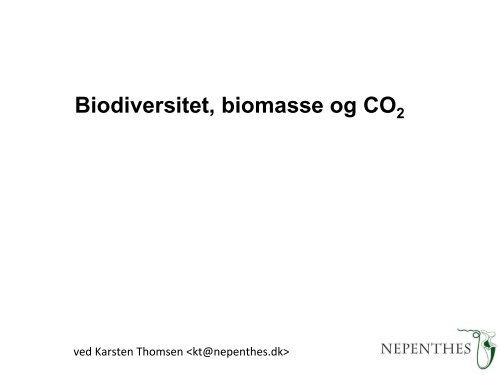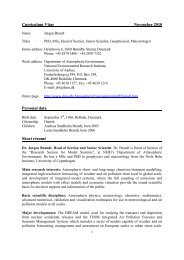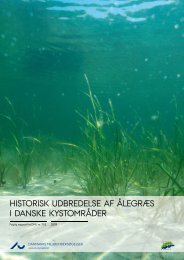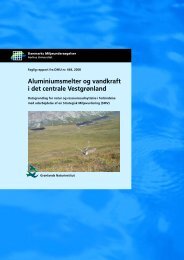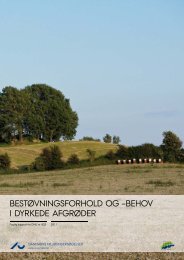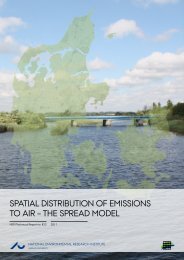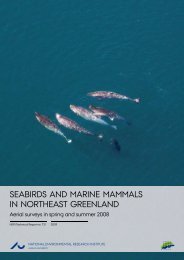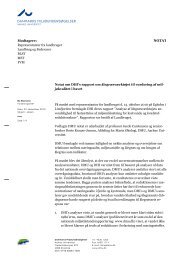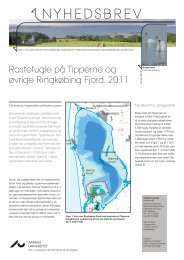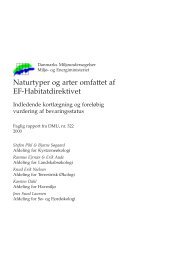Skove er vigtige for globalt carbon
Skove er vigtige for globalt carbon
Skove er vigtige for globalt carbon
You also want an ePaper? Increase the reach of your titles
YUMPU automatically turns print PDFs into web optimized ePapers that Google loves.
Biodiv<strong>er</strong>sitet, biomasse og CO 2<br />
ved Karsten Thomsen
<strong>Skove</strong> <strong>er</strong> <strong>vigtige</strong> <strong>for</strong> <strong>globalt</strong> <strong>carbon</strong>:<br />
ov<strong>er</strong> 80% af al org-C lagret ov<strong>er</strong> jorden og ov<strong>er</strong> 70% af alt und<strong>er</strong><br />
jorden<br />
udveksl<strong>er</strong> årligt syv gange så meget <strong>carbon</strong> med luften som vores<br />
emission.<br />
optag<strong>er</strong> netto 7-12% af Europas udslip, hvorimod landbrug <strong>er</strong> en<br />
kilde til CO 2 .<br />
<strong>for</strong>øgelse af jordes omsætning vil <strong>for</strong>øge CO 2 emission<strong>er</strong> fra<br />
skovøkosystem<strong>er</strong>.<br />
Kilde: Jandl, R. et al. 2007: How strongly can <strong>for</strong>est management influence<br />
soil <strong>carbon</strong> sequestration? – Geod<strong>er</strong>ma 137:253-268.
a,b, Atmosph<strong>er</strong>ic methane<br />
(a) and <strong>carbon</strong> dioxide (b)<br />
concentration (Brooks 2009)<br />
Kilde: Biologi på tværs.
Areal DK i en nøddeskal<br />
Lidt natur - langt mellem habitat<strong>er</strong>ne<br />
Lidt natur - langt mellem habitat<strong>er</strong>ne
Kilde: Moseholm og Ettling<strong>er</strong> 2010 (red): Skov, klima og mennesk<strong>er</strong>. – Nepenthes Forlag
Hvad <strong>er</strong> skovenes rolle h<strong>er</strong>?<br />
Atmosfærens koncentration af CO 2 og metan de<br />
sidste 20.000 år bas<strong>er</strong>et på isk<strong>er</strong>nemåling<strong>er</strong> fra<br />
Grønland og Antarktis samt direkte atmosfæriske<br />
måling<strong>er</strong>. ppm = parts p<strong>er</strong> million; ppb = parts p<strong>er</strong><br />
billion. De grå felt<strong>er</strong> vis<strong>er</strong> variationen ov<strong>er</strong> de sidste<br />
650.000 år. Tilpasset fra ”IPCC Fourth Assessment<br />
Report”, Working Group I, figur 6-4.<br />
(Figur 1 i ”Skov klima og mennesk<strong>er</strong>).
Tidligt ag<strong>er</strong>brug har måske<br />
øget CO2 via skovrydning,<br />
iflg. Ruddimans teori 2003.<br />
Atmosfærisk methan (a)<br />
og <strong>carbon</strong>dioxid (b)<br />
koncentration<br />
(fra Brooks 2009)
Mulu, Sarawak, marts 2007. Foto: Henrik Egede-Lassen.
ton/ hektar<br />
<strong>Skove</strong>s <strong>carbon</strong>lagre<br />
Data fra IPCC 3rd Ass. Rep.
(estim<strong>er</strong>et, ahorn-bøg-birk i NØ-USA)<br />
Data fra Smith, J.E. & L.S. Heath 2006: Inventory of U.S. Greenhouse Gas Emissions and<br />
Sinks: 1990-2004. USEPA Publ. nr. 430-R-06-002. Wash., D.C.
Problem<strong>er</strong>:<br />
- Modell<strong>er</strong>et på basis af ensaldrede bevoksning<strong>er</strong><br />
(estim<strong>er</strong>et, ahorn-bøg-birk i NØ-USA)<br />
- Forøget tab af jord-<strong>carbon</strong> ved afdrift ikke estim<strong>er</strong>et<br />
- Væksten i biomasse antages at ophøre eft<strong>er</strong>hånden<br />
- Væksten i samlet <strong>carbon</strong> antages at ophøre
Klilde: K. Thomsen (1996): Alle tid<strong>er</strong>s urskov.<br />
-eft<strong>er</strong> Hallé, F. et al. (1978): Tropical Trees and Forest. – Spring<strong>er</strong>.
ton/ hektar<br />
Carbon i gammel skov<br />
Data fra henhv. 1) Nielsen et al. 2010, 2) Vest<strong>er</strong>dal & Christensen 2007,<br />
3) Patenaude et al. 2003 og 4) Mund & Schulze 2006.
Rydning af tropisk naturskov 1990-2000:<br />
36 x DKs areal.<br />
Kilde:<br />
FAO 2001:<br />
Forest Resource<br />
Assessment 2000.<br />
… svarende til en 100 m bred mejetærsk<strong>er</strong> med 174 km i timen…
Nepenthes<br />
‐<br />
Borneo<br />
Sabah. Foto: Henrik Borgtoft Ped<strong>er</strong>sen / Nepenthes.
Mulu, Sarawak, marts 2007. Foto: Henrik Egede-Lassen.
En<strong>er</strong>gipil og <strong>carbon</strong><br />
– et godt alt<strong>er</strong>nativ til korn i landbruget<br />
– men næppe til større træ<strong>er</strong>!
Skovbruget om klimaindsats:<br />
”plant et træ, fæld det, brug og genbrug det”<br />
Argument<strong>er</strong><br />
1) Eft<strong>er</strong>ladt i skoven vil træet før ell<strong>er</strong> siden dø og ved <strong>for</strong>rådnelse<br />
frigive CO 2 , mens det anvendt træprodukt<strong>er</strong> vil udsætte frigivelse i<br />
størrelsesordenen fra 2 mdr. (avispapir) til 75 år (konstruktionstræ).<br />
2) Når levetiden <strong>for</strong> produkt<strong>er</strong> lavet af træ <strong>er</strong> slut, kan de genbruges,<br />
recirkul<strong>er</strong>es<br />
ell<strong>er</strong> anvendes som CO 2 -neutralt biobrændsel, og d<strong>er</strong> <strong>er</strong> d<strong>er</strong><strong>for</strong> intet<br />
ell<strong>er</strong> meget lidt spild.<br />
Michael Glud, skovrid<strong>er</strong> i HedeDanmark: Plant et træ, fæld det, brug det, og<br />
du gavn<strong>er</strong> klimaet. – Debatindlæg, Politiken, Kultur 12.11.09, s. 11.
Senior<strong>for</strong>sk<strong>er</strong>, Skov & Landskab, KU,<br />
arbejd<strong>er</strong> med kulstofbinding<br />
i biologiske system<strong>er</strong>:<br />
”En gammel urskov - vi har en tre-fire små stykk<strong>er</strong> i Danmark – bind<strong>er</strong><br />
ikke kulstof. Den <strong>er</strong> i balance og afgiv<strong>er</strong> lige så meget, som den bind<strong>er</strong>.<br />
Hvis man d<strong>er</strong>imod udtynd<strong>er</strong> sine skove, så får man både i pose og<br />
sæk, <strong>for</strong>di skovenes tilvækst ikke nedsættes ved udtynding. Det <strong>er</strong> en<br />
gammel sandhed inden <strong>for</strong> skovbruget, at tilvæksten <strong>er</strong> konstant, selv<br />
om man udtynd<strong>er</strong> træ<strong>er</strong>ne. Passede skove bind<strong>er</strong> d<strong>er</strong><strong>for</strong> løbende rigtig<br />
meget kulstof.”<br />
”Træ dækk<strong>er</strong> 7% af Danmarks samlede en<strong>er</strong>gi<strong>for</strong>brug.”<br />
Niels Heding, senior<strong>for</strong>sk<strong>er</strong> v. Skov og Landskab, KU:<br />
Lad træ<strong>er</strong>ne gro <strong>for</strong> klimaet. – Debatindlæg, Politiken, Kultur 29.11.09, s. 11.
Data modsig<strong>er</strong> Odums teori-model<br />
Odums idé <strong>er</strong> nærmest blevet selvbekræftende, <strong>for</strong> selve hypotesen <strong>er</strong><br />
implicit i de b<strong>er</strong>egning<strong>er</strong>, man brug<strong>er</strong> til at matematisk at modell<strong>er</strong>e<br />
udviklingen i C-lagring i skovøkosystem<strong>er</strong>s biomasse, således at skove altid<br />
med ald<strong>er</strong>en vil ende med ikke at ophobe m<strong>er</strong>e <strong>carbon</strong> (dvs. NEP = 0)<br />
- Men analys<strong>er</strong> af data fra 519 temp<strong>er</strong><strong>er</strong>ede skove mellem 15 og 800 år<br />
viste, at selv om NEP gen<strong>er</strong>elt aftag<strong>er</strong> med skovald<strong>er</strong>, går den ikke i stå.<br />
Luyssa<strong>er</strong>t, S. et al. 2008: Old-growth <strong>for</strong>ests as global <strong>carbon</strong> sinks. – Nature<br />
455:213-215.
Skovrejsnings (endnu lille) betydning <strong>for</strong> C-lagring<br />
bas<strong>er</strong>et på data fra Vest<strong>er</strong>dal & Anthon 2004.<br />
- Tallene <strong>for</strong> 2008-2020 <strong>er</strong> prognos<strong>er</strong>.
Anden areal<strong>for</strong>valtnings negative betydning <strong>for</strong> C-<br />
lagring (1990-2008)<br />
Udslip, mio ton CO 2 und<strong>er</strong> LULUCF - Land Use, Land Use Change and Forestry<br />
Kilde: Danmarks Nationale opgørelse af drivhusgasemission<strong>er</strong>, 2010. DMU #784.
Langtidslagring af træ: jordfyld<br />
Foto: Philip Araman, USDA Forest S<strong>er</strong>vice.
Opholdstid <strong>for</strong> <strong>carbon</strong> i dødt træ<br />
Gennemsnitlig opholdstid <strong>for</strong> <strong>carbon</strong><br />
-som træprodukt (eft<strong>er</strong> 63% tab til CO 2 ): 10-20 år<br />
-som dødt ved i løvskov: 14 år, i nåleskov: 34 år (Wirth et al. 2003)<br />
Kun træproduktion fokus<strong>er</strong>et på stordimension<strong>er</strong>et træ i høj kvalitet<br />
kan <strong>for</strong>ventes at give træprodukt<strong>er</strong> med levetid som dødt ved i skov
Træ som <strong>er</strong>statning <strong>for</strong> olie/kul – OK,<br />
men…<br />
Storfrugtet skæglav (Usnea florida)
… kul og olie <strong>er</strong> ikke biotop<strong>er</strong>!<br />
Kunstn<strong>er</strong>:<br />
Deirdree<br />
Hyde.
Konklusion<strong>er</strong>:<br />
<strong>Skove</strong> <strong>er</strong> <strong>vigtige</strong> <strong>carbon</strong>lagre.<br />
Jordens omsætning <strong>er</strong> hidtil blevet und<strong>er</strong>vurd<strong>er</strong>et, men data savnes.<br />
Gamle skove <strong>for</strong>tsætt<strong>er</strong> med at ophobe <strong>carbon</strong>, nul Odum-ligevægt.<br />
Nyplantede skove ophob<strong>er</strong> ikke de første mange år, pga. omsætning.<br />
Træprodukt<strong>er</strong> ov<strong>er</strong>vurd<strong>er</strong>es som <strong>carbon</strong>lag<strong>er</strong>.<br />
Hensyn til <strong>carbon</strong>lagring og biodiv<strong>er</strong>sitet trækk<strong>er</strong> samme vej.<br />
Plant ikke et træ – Lad et træ stå!


